Our historic Ford V8 fire truck will soon celebrate 50 years at MOTAT
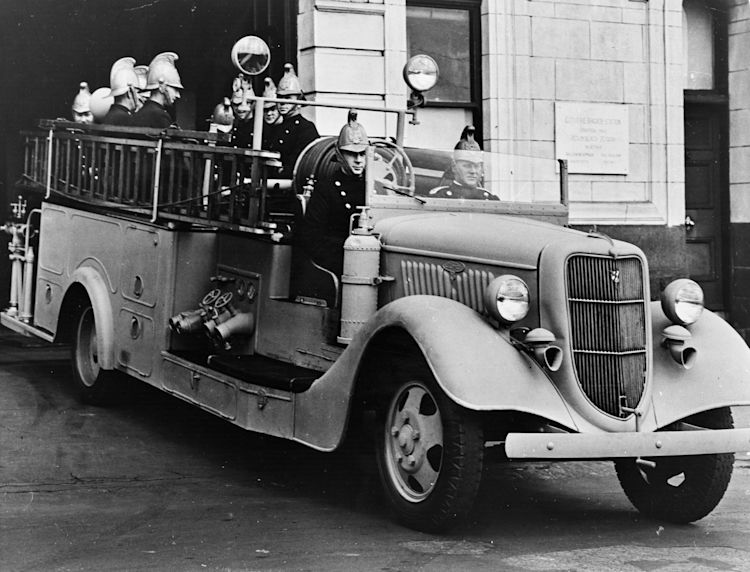
Nicknamed "The Rattler", the Ford V8 was first of this type of engine bought by the Auckland Metropolitan Fire Board (formed 1933). The engine was recommended by Superintendent William L. Wilson and ordered by the Board in August 1935 at a cost of £853.[i] The engine was ordered after a March 1935 report submitted to parliament on the state of fire brigades in the Dominion, which made the case to replace hose-tenders and out dated engines with modern fire engines equipped with pumps that could be modified for local requirements. The Inspector of Fire Brigades at the time wrote that the speeds these new engines could achieve (up to 30 miles per hour or 50 kilometres per hour in traffic, or faster when the route was clear) was crucial for preventing spread of fire because of faster arrival times, as well as increasing the radius each fire station could attend to in emergencies.[ii]
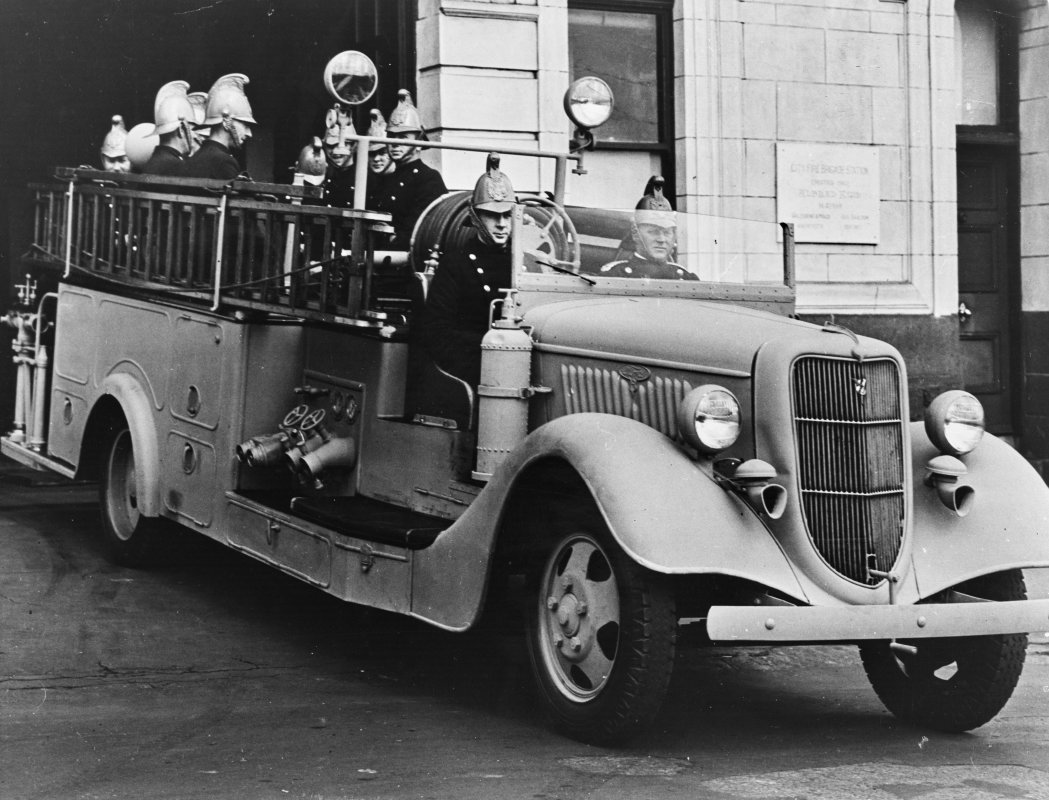
The chassis of this appliance is of Canadian manufacture and was assembled in Wellington, while the bodywork was built locally in Auckland.[iii]The chassis was imported to Wellington where the importer and Ford Canada franchisee, Colonial Motor Company Limited, was based.[iv] The bodywork was completed by Auckland coach building company Cavanagh (est. 1922).[v] This firm had factories at 108-110 Symonds Street and quickly built up a reputation for commercial truck body building and spring and wheel manufacture in their first decade.[vi] Cavanagh completed the bodywork by March 1936 and the engine went into service with the brigade. It was trialled along Auckland’s waterfront on the 4th of March, with all equipment fitted.[vii] Several trial runs were carried out over the following weeks as firefighters familiarised themselves with the vehicle. This involved early morning road closures along Tamaki Drive with high-speed driver training.[viii]
The fire engine featured notable differences from previous machines operated by the Auckland’s fire brigades. The pump is transversely located behind the gearbox, instead of at the rear of the chassis and could pump 1800 litres or 400 gallons of water per minute at a pressure of 120lb to the square inch.[ix] The pump was driven by the main engine and operated by a lever at the side of the gear change.[x] The pump’s capabilities were highlighted in a demonstration on 21st November 1935 at Mechanics Bay, given by the jetty opposite the railway engine sheds.[xi]

Along with the chassis, the pump was also assembled and modified by the Colonial Motor Company (CMC), who had established a branch for the manufacture of fire engines and firefighting equipment.[xii] It was one of the two standard turbine pumps the company offered and was centrifugal , as opposed to a rotary or positive displacement pump, after the latter was found unsuitable by local brigades.[xiii] CMC based this centrifugal pump on the two stage British Gwynne model produced by Gywnne Limited, a company that lead development and sale of the centrifugal pump invented by James Gwynne.[xiv] The pump’s basic operating principle is that it uses centrifugal energy to increase the speed and pressure of fluid passed through it, making it ideal for fire response.[xv] CMC worked closely with Superintendent of the Wellington Fire Brigade, Charles Alexander Woolley, on the design of Ford fire engines of the 1930s.[xvi]
Accommodation for up to 8 firefighters included being able to sit inside a well in the vehicle and face each other. Two firefighters could also stand at the rear, facing forward to the engine, instead of outward as on previous machines.[xvii] This reconfiguration into the well posed less risk to those in the moving vehicle, who could sometimes fly off fire engines because of the faster speeds able to be achieved when pneumatic tyres (inflated rubber) were introduced in the 1930s. The New Zealand Herald also reported an improvement in the appliance’s ability to discharge hoses from the rear, so that they could be paid out as the engine approached the scene of a fire. Older machines required firefighters to jump off before securing hoses from lockers under the seats.[xviii] The ladder was placed on one side, with the suction hose on the other to help with weight balance to keep the centre of gravity low.[xix]
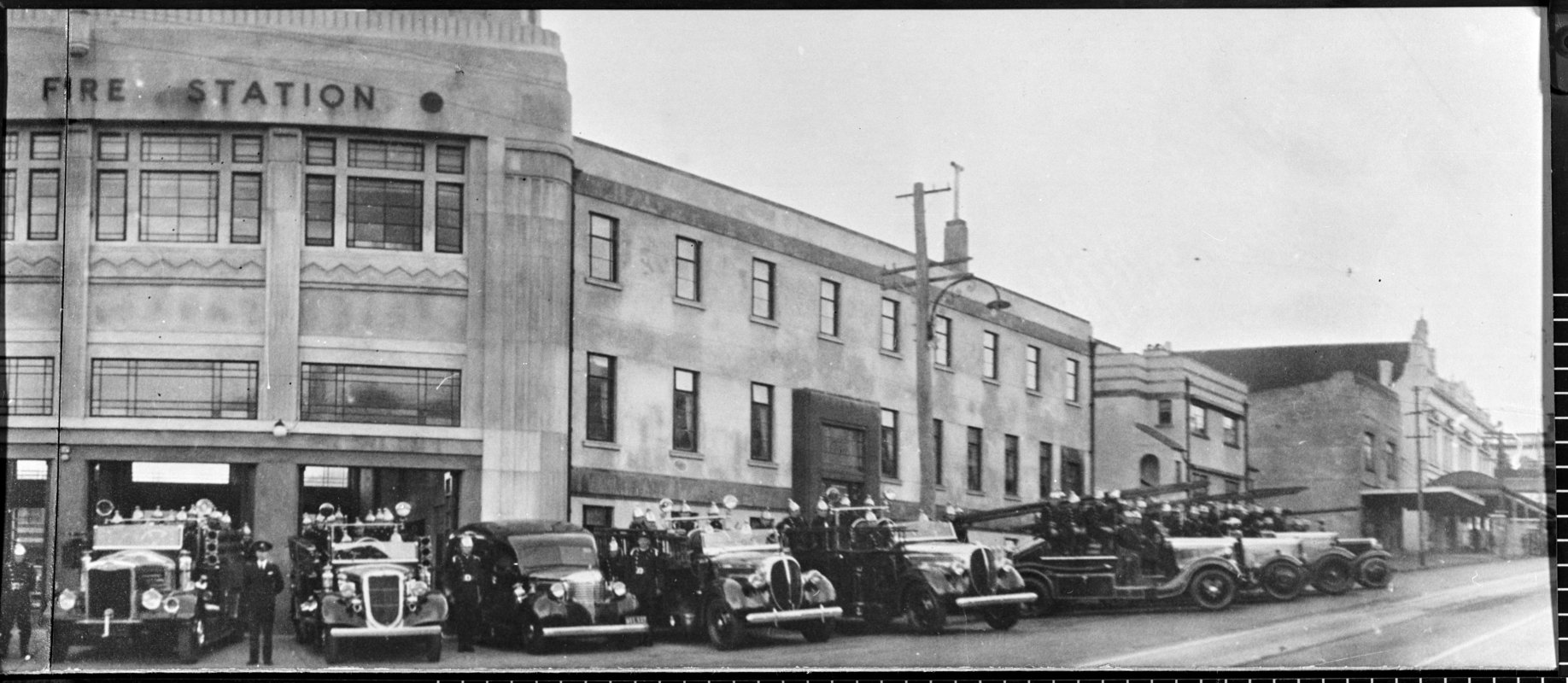
Ford V8
The use of a Ford V8 engine is also part of this fire appliance’s significance. The Ford Flathead V8 engine was first introduced by the company in 1932 and designed for production by Carl Schmaltz, Ray Lard, and Mil Zoerlein. It is an eight -cylinder piston engine with four cylinders in each bank arranged in a V configuration, making it both powerful and well balanced in design (meaning lower engine vibrations). Ford were the first company to manufacture a V8 engine where affordability and performance were matched.[xx] Along with suitability for fire appliances, these engines were also used on automobiles such as the Ford Model 18. This engine type was included in Ward’s top ten engines of the 20th century, based on automobile engines available in the U.S. market in that period. The Auckland Fire Brigade Museum and Historical Society notes that these Ford appliances were valued for their ease of maintenance, with two mechanics being able to replace a worn engine within a couple of hours and put the appliance back in commission quickly.[xxi]
Service history
This vehicle served for many years as the "Flyer" a service term for the first engine out of the Headquarters Station. The flying squad was a feature of the service for many years and could be relied upon to turn out in under 25 seconds day or night. It stayed as the no. 1 pump at Pitt Street’s Station for 15 years before it moved in 1954 to Ōtāhuhu as their no. 2 pump. It went back to Auckland’s headquarters in 1960 where it was converted to a foam tender carrying foam making equipment used on fires that involved flammable liquids. In 1965 the engine was sold to the North Shore Fire Board, operating out of Devonport until 1974.
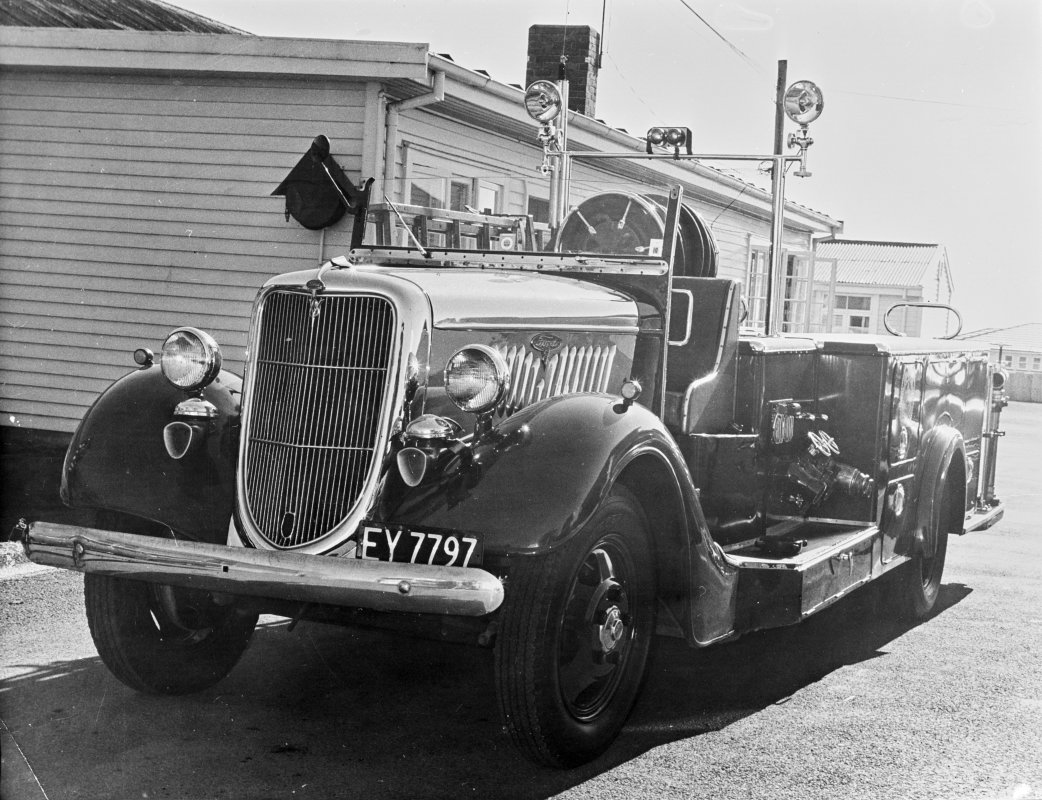
Donation to MOTAT
The Ford was donated to MOTAT by the North Shore Fire Board and is recorded in the March 1975 annual report as being one of the major additions to the collection from 1974.[xxii] The Museum’s newsletter reported that it arrived in good condition and was featured as part of regular Saturday and Sunday displays, along with special promotions and parades. In 1981, it was included in a parade for MOTAT’s 21st birthday celebrations, as well as for a Government Tourism promotion.[xxiii] Next year, it will celebrate 50 years in the MOTAT Collection, which coincides with the 150th anniversary of organised firefighting in Auckland.
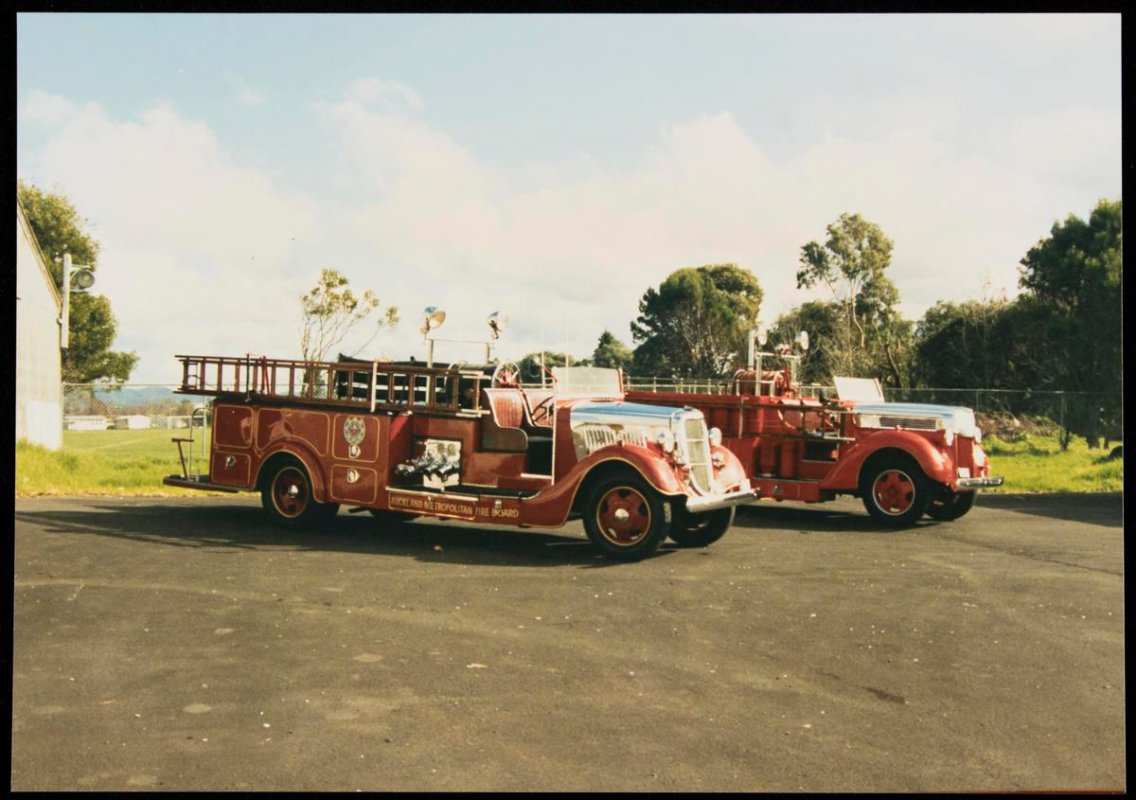
The engine is currently in MOTAT’s Road Transport Workshop where it is being worked on to preserve the mechanical system. The clutch is being replaced with genuine parts being supplied from the United States and the bottom end of the engine is being resealed to prevent water leaks into the oil system. The electrics of the ignition are also being replaced and restored to original condition. The continued care for this vehicle by MOTAT will ensure that its history and significance as a story of local manufacture can continued to be told for generations to come.
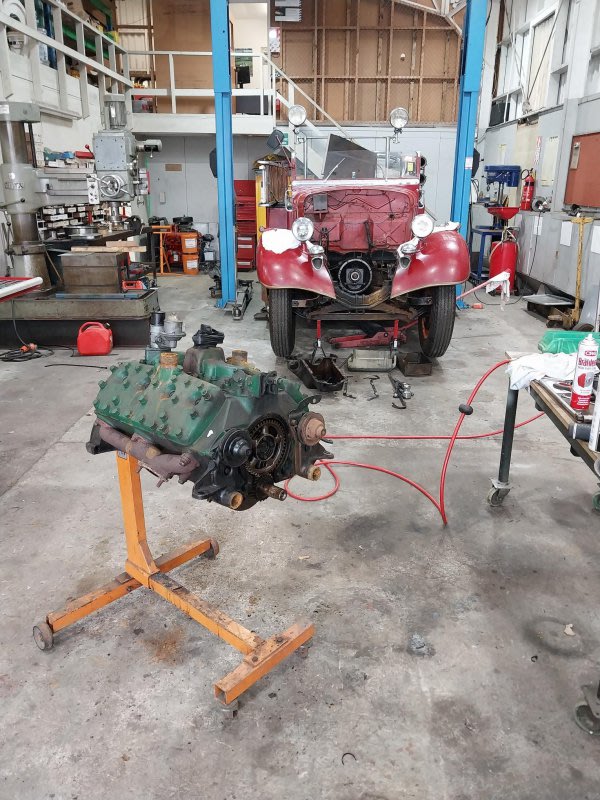
Ford 1934 V8 Fire Engine specifications:
Type: Pumping appliance
Manufacturer: Ford Canada, imported by Colonial Motor Company Limited (Wellington)
Country manufactured: Canada, New Zealand
Engine type: Ford
Engine capacity: V8
Pump: Colonial Motor Company Limited (also referred to as Colmoco)
Pumping capacity: 1800 litres (395 gallons) per minute
No. of firefighters needed: 8
See links
https://www.afbhs.co.nz/
https://atojs.natlib.govt.nz/cgi-bin/atojs
https://www.colmotor.co.nz
https://themotorhood.com/
https://paperspast.natlib.govt.nz/
Sources
[i]New Zealand Herald, Volume LXXII, Issue 22200, 29 August 1935, Page 12. Accessed 20 Jan, 2023: https://paperspast.natlib.govt.nz/newspapers/NZH19350829.2.96
[ii]Fire Brigades of the Dominion (report on the) for the year ended 31st March, 1935, by the Inspector of Fire Brigades. In Appendix to the Journals of the House of Representatives, 1935 Session I, H-12. Accessed 20 Jan, 2023: https://atojs.natlib.govt.nz/cgi-bin/atojs?a=d&d=AJHR1935-I.2.3.2.12&cl=search&srpos=12&e=-------10--11---bySH---0-AJHR%5f1935%5fI%5fHZz-I-&st=1
[iii]New Zealand Herald, Volume LXXII, Issue 22200, 29 August 1935, Page 12. Accessed 20 Jan, 2023: https://paperspast.natlib.govt.nz/newspapers/NZH19350829.2.96 and New Zealand Herald, Volume LXXII, Issue 22271, 20 November 1935, Page 12. Accessed 20 Jan 2023: https://paperspast.natlib.govt.nz/newspapers/NZH19351120.2.70
[iv]CMC was a franchisee of Ford Canada between 1911 and 1936, when Ford Motor Company of New Zealand took over distribution of Ford productions in New Zealand. See more here: https://www.colmotor.co.nz/about/history/
[v]Priority Message (Journal of the Auckland Fire Brigade Museum and Historical Society), vol. 9 no. 4 (Sep – Nov 2018), page 2. Accessed 20 Jan 2023: https://issuu.com/colinprince/docs/vol_9_no_4 and Auckland Star, Volume LIV, Issue 300, 17 December 1923, Page 9. Accessed 20 Jan 2023: https://paperspast.natlib.govt.nz/newspapers/AS19231217.2.136
[vi]Auckland Star, Volume LXI, Issue 297, 16 December 1930, Page 9. Accessed 20 Jan 2023: https://paperspast.natlib.govt.nz/newspapers/AS19301216.2.119
[vii]New Zealand Herald, Volume LXXIII, Issue 22359, 4 March 1936, Page 8. Accessed 20 Jan 2023: https://paperspast.natlib.govt.nz/newspapers/NZH19360304.2.30.4 and New Zealand Herald, Volume LXXIII, Issue 22359, 4 March 1936, Page 13. Accessed 20 Jan 2023: https://paperspast.natlib.govt.nz/newspapers/NZH19360304.2.131
[viii]Auckland Star, Volume LXVII, Issue 54, 4 March 1936, Page 6. Accessed 20 Jan 2023: https://paperspast.natlib.govt.nz/newspapers/AS19360304.2.29 and Priority Message (Journal of the Auckland Fire Brigade Museum and Historical Society), vol. 9 no. 4 (Sep – Nov 2018), page 2. Accessed 20 Jan 2023: https://issuu.com/colinprince/docs/vol_9_no_4
[ix]New Zealand Herald, Volume LXXII, Issue 22273, 22 November 1935, Page 14. Accessed 20 Jan 2023: https://paperspast.natlib.govt.nz/newspapers/NZH19351122.2.97
[x]Auckland Star, Volume LXVI, Issue 277, 22 November 1935, Page 6. Accessed 20 Jan 2023: https://paperspast.natlib.govt.nz/newspapers/AS19351122.2.30
[xi]Auckland Star, Volume LXVI, Issue 276, 21 November 1935, Page 8. Accessed 20 Jan 2023: https://paperspast.natlib.govt.nz/newspapers/AS19351121.2.80
[xii]Fire Brigades of the Dominion (report on the) by the Inspector of Fire Brigades. InAppendix to the Journals of the House of Representatives, 1945 Session I, H-12. Accessed 20 Jan 2023: https://atojs.natlib.govt.nz/cgi-bin/atojs?a=d&d=AJHR1945-I.2.2.5.14&cl=&srpos=0&e=-------10--1------0--
[xiii]Ibid.
[xiv]Auckland Fire Brigade Museum and Historical Society’s Facebook page. Accessed 20 Jan 2023: https://www.facebook.com/firehistorical/photos/a.167030230006923/4689928677717033/
[xv] Hydro Innovations. N.d. What is a centrifugal pump? Accessed 20 Jan 2023: https://www.hydroinnovations.com.au/training/what-is-a-centrifugal-pump/
[xvi]MOTAT Correspondence with Auckland Fire Brigade Museum and Historical Society. January 2023.
[xvii]New Zealand Herald, Volume LXXIII, Issue 22359, 4 March 1936, Page 8. Accessed 20 Jan 2023: https://paperspast.natlib.govt.nz/newspapers/NZH19360304.2.30.4
[xviii]New Zealand Herald, Volume LXXIII, Issue 22359, 4 March 1936, Page 13. Accessed 20 Jan 2023: https://paperspast.natlib.govt.nz/newspapers/NZH19360304.2.131
[xix]New Zealand Herald, Volume LXXII, Issue 22271, 20 November 1935, Page 12. Accessed 20 Jan 2023: https://paperspast.natlib.govt.nz/newspapers/NZH19351120.2.70
[xx]Ashley Webb. 2015. The history of Ford’s iconic flathead engine. Accessed 20 Jan 2023: https://themotorhood.com/themotorhood/2015/9/22/the-history-of-fords-iconic-flathead-engine#:~:text=Ford's%20flathead%20V8%20is%20the,Ray%20Lard%2C%20and%20Mil%20Zoerlein.
[xxi]MOTAT Correspondence with Auckland Fire Brigade Museum and Historical Society. January 2023.
[xxii]MOTAT. Museum News, March 1975 issue.
[xxiii]MOTAT. Museum News, December 1981 issue.
Credits
Story by Chelsea Renshaw, Curator - Transport, MOTAT
Story edited with thanks to the Auckland Fire Brigade Museum and Historical Society.
Citation:
Renshaw, Chelsea, 2022. A modern pumping appliance for the Auckland Metropolitan Fire Board: The 1935 Ford V8.
MOTAT Museum of Transport and Technology. Published: 3 February 2023. URL: https://www.motat.nz/collections-and-stories/stories/nicknamed-the-rattler-historical
Find more stories about the past, present, and future technology of Aotearoa here.